Wounds: Difference between revisions
No edit summary |
(Removed massive wound-related tables, added references to the article itself) |
||
| Line 1: | Line 1: | ||
''This article is about the noun "wound," as in "wound token." For the verb, as in "wound a character," see [[Wounding]]'' | |||
[[File:LOTR-EN01S250.0_card.jpg|right|Good, good, let it flow through...what do you mean, "wrong franchise"?]] | [[File:LOTR-EN01S250.0_card.jpg|right|Good, good, let it flow through...what do you mean, "wrong franchise"?]] | ||
'''Wounds''' are used to represent injury sustained in battle that affects a character's vitality. Wounds are shown through the use of | '''Wounds''' are used to represent injury sustained in battle that affects a character's vitality. Wounds are shown through the use of wound tokens, which are usually blood-red glass beads. Once a character has wounds equal to their vitality, they are immediately killed. This is in contrast to [[exert|exertions]], which cannot remove a character's final point of vitality. | ||
The most common way that wounds occur is through losing [[ | The most common way that wounds occur is through losing [[Skirmish Phase|skirmishes]]; once a skirmish has resolved, the losing characters each receive one wound (or more if the winner has any '''[[damage]]''' bonuses). [[Archery]] is also a common form of [[Wounding|wound-dealing]], either through indirect archery fire (that is, your opponent gets to pick where the arrows land) or directed archery fire (such as through use of cards such as {{Card|Legolas, Greenleaf}} or {{Card|Aragorn's Bow}}). In [[King block]] and beyond, [[threats]] also became a potent form of wounding, with mechanics similar to a surprise Archery phase. | ||
However, there are a great many cards that allow wounds to be assigned at plenty of other times, such as Hate shown to the right. | However, there are a great many cards that allow wounds to be assigned at plenty of other times, such as Hate shown to the right. {{C|Sauron}} orcs in particular are well-known for this type of direct exert-to-wound setup, but {{C|Raider}} men and {{C|Isengard}} orcs also have a number of cards that deal wounds in similar ways. Use the [[Advanced Card Search]] to find a list of such cards. | ||
Preventing wounds is done through a number of different avenues depending on the culture. | [[Wound Prevention|Preventing wounds]] is done through a number of different avenues depending on the culture. {{C|Gandalf}}, for instance, relies primarily on [[spell]] [[events]] such as {{Card|Intimidate}} to prevent wounds at the last moment, whereas {{C|Gondor}} and {{C|Dwarf}} have possessions such as {{Card|Armor}} and {{Card|Gimli's Helm}}, respectively. Wound prevention can certainly be a powerful avenue to keeping your Fellowship alive, but for most decks it's a secondary consideration at best, since [[healing]] is more versatile (in that it can also help against exertions). | ||
See also exhausted, heal, exert, threat. | See also [[exhausted]], [[heal]], [[exert]], [[threat]]. | ||
{{RulesQuote | |||
|source=wound | |||
When a character is wounded by an enemy attack, his vitality is depleted. Place a | |text=When a character is wounded by an enemy attack, his vitality is depleted. Place a wound token on the character to illustrate this. Glass beads (preferably blood red) make good tokens for this purpose. | ||
Wounds are always placed on a character one at a time. | Wounds are always placed on a character one at a time. | ||
| Line 26: | Line 28: | ||
If a character cannot take wounds, wounds cannot be assigned to that character. However, if a card prevents wounds, wounds may still be assigned to that character. | If a character cannot take wounds, wounds cannot be assigned to that character. However, if a card prevents wounds, wounds may still be assigned to that character. | ||
''Faramir, Wizard’s Pupil reads: “Skirmish: Exert Gandalf to prevent all wounds to Faramir.” This prevents wounds as they are assigned to Faramir, not the assignments themselves.'' | ''Faramir, Wizard’s Pupil reads: “Skirmish: Exert Gandalf to prevent all wounds to Faramir.” This prevents wounds as they are assigned to Faramir, not the assignments themselves.''}} | ||
---- | ---- | ||
Latest revision as of 17:25, 9 January 2024
This article is about the noun "wound," as in "wound token." For the verb, as in "wound a character," see Wounding
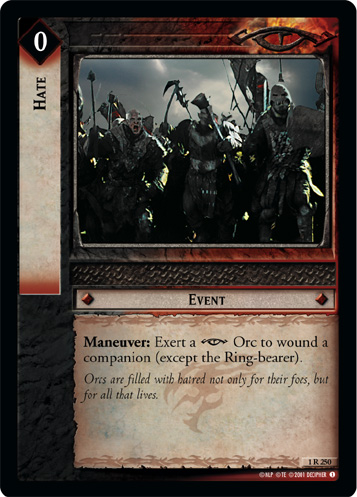
Wounds are used to represent injury sustained in battle that affects a character's vitality. Wounds are shown through the use of wound tokens, which are usually blood-red glass beads. Once a character has wounds equal to their vitality, they are immediately killed. This is in contrast to exertions, which cannot remove a character's final point of vitality.
The most common way that wounds occur is through losing skirmishes; once a skirmish has resolved, the losing characters each receive one wound (or more if the winner has any damage bonuses). Archery is also a common form of wound-dealing, either through indirect archery fire (that is, your opponent gets to pick where the arrows land) or directed archery fire (such as through use of cards such as Legolas, Greenleaf (1R50)
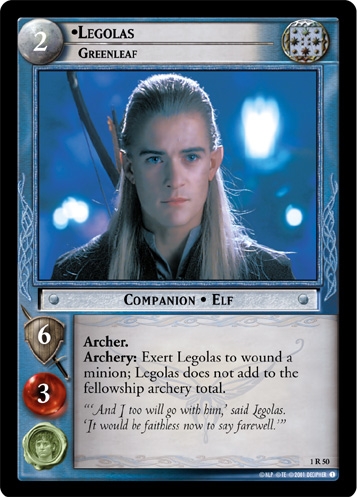 or Aragorn’s Bow (1R90)
or Aragorn’s Bow (1R90)
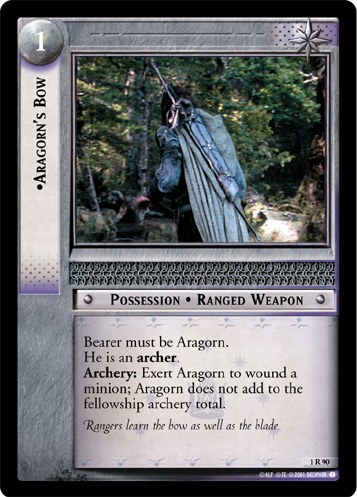 ). In King block and beyond, threats also became a potent form of wounding, with mechanics similar to a surprise Archery phase.
). In King block and beyond, threats also became a potent form of wounding, with mechanics similar to a surprise Archery phase.
However, there are a great many cards that allow wounds to be assigned at plenty of other times, such as Hate shown to the right. Sauron orcs in particular are well-known for this type of direct exert-to-wound setup, but
Raider men and
Isengard orcs also have a number of cards that deal wounds in similar ways. Use the Advanced Card Search to find a list of such cards.
Preventing wounds is done through a number of different avenues depending on the culture. Gandalf, for instance, relies primarily on spell events such as Intimidate (1C76)
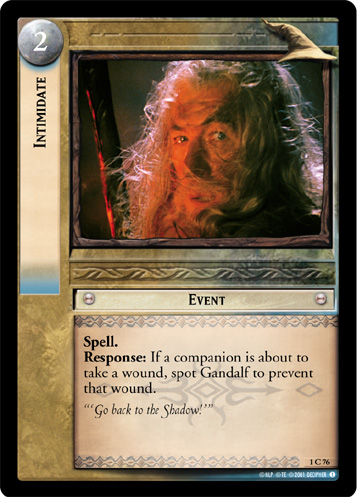 to prevent wounds at the last moment, whereas
to prevent wounds at the last moment, whereas Gondor and
Dwarf have possessions such as Armor (1C92)
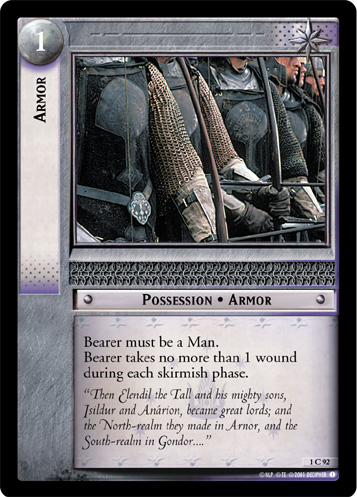 and Gimli's Helm (1R15)
and Gimli's Helm (1R15)
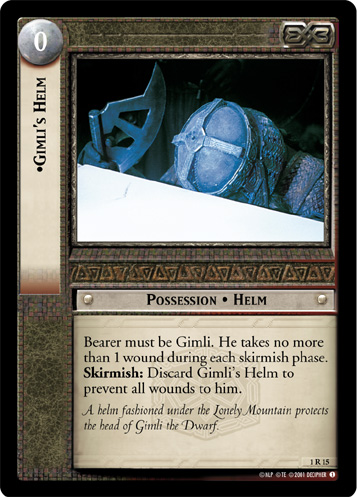 , respectively. Wound prevention can certainly be a powerful avenue to keeping your Fellowship alive, but for most decks it's a secondary consideration at best, since healing is more versatile (in that it can also help against exertions).
, respectively. Wound prevention can certainly be a powerful avenue to keeping your Fellowship alive, but for most decks it's a secondary consideration at best, since healing is more versatile (in that it can also help against exertions).
See also exhausted, heal, exert, threat.
When a character is wounded by an enemy attack, his vitality is depleted. Place a wound token on the character to illustrate this. Glass beads (preferably blood red) make good tokens for this purpose.
Wounds are always placed on a character one at a time.
When you “wound a character,” you place only one wound.
If a card tells you to wound a number of companions, you must choose different companions to wound one time each (you cannot wound a single companion more than once).
A wounded character is a character who has at least one wound token.
If a character cannot take wounds, wounds cannot be assigned to that character. However, if a card prevents wounds, wounds may still be assigned to that character.
Faramir, Wizard’s Pupil reads: “Skirmish: Exert Gandalf to prevent all wounds to Faramir.” This prevents wounds as they are assigned to Faramir, not the assignments themselves.- wound section
| Actions | ||||||||||
|---|---|---|---|---|---|---|---|---|---|---|
| General | At Random | Can/Cannot | Cost | Effect | May | Limit | Pass | Prevent | Spot | Up To |
| Triggers | At the Start | Each Time | When | While | ||||||
| Phase Actions | Assign | Cancel | Special Ability | Response | ||||||
| Character Actions | Corrupt | Exert | Exhaust | Heal | Kill | Overwhelm | Participate | Wound | ||
| Site Actions | At a Site | Control | Liberate | Replace | ||||||
| Card Actions | Draw | Discard | Play | Reveal | Reconcile | Shuffle | Stack | Transfer | ||